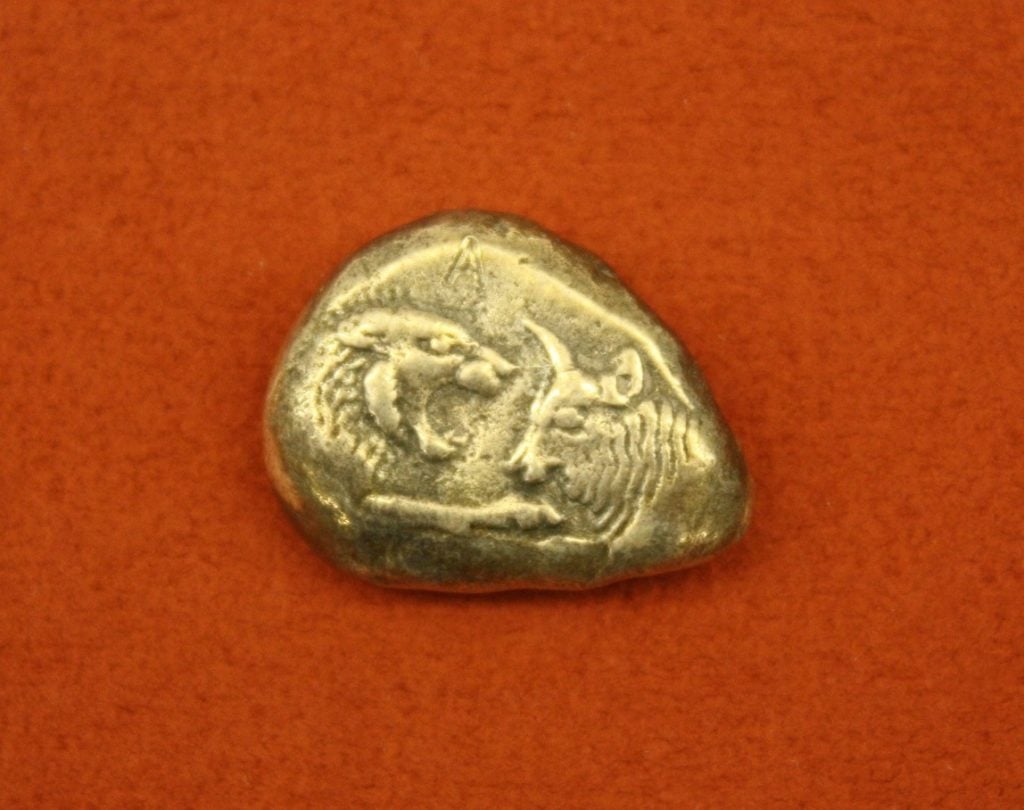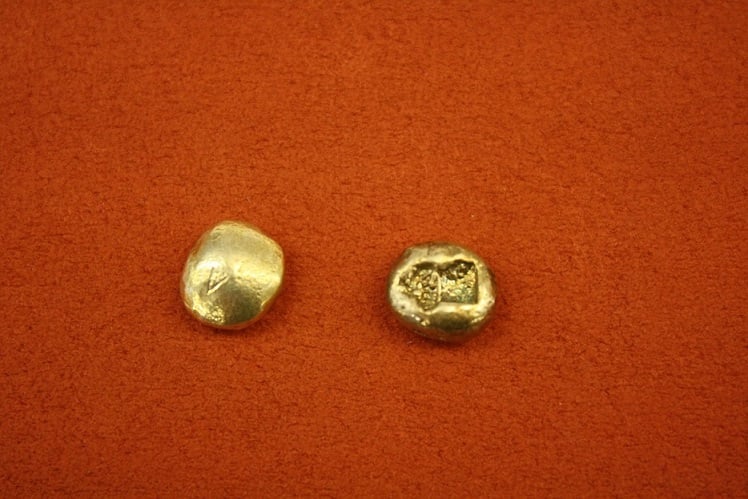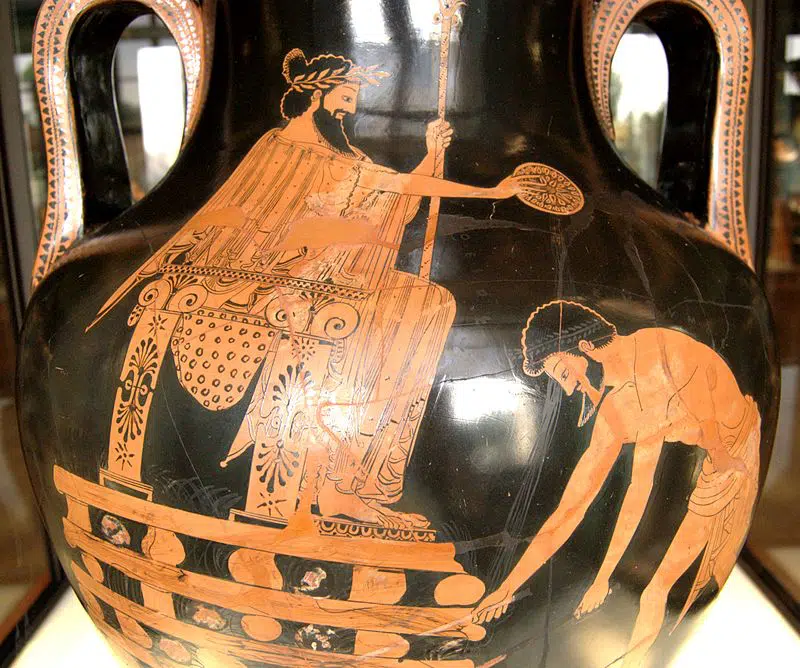
Ancient Lydia holds the distinction of creating the first coins in the world; at first not much more than blobs of metal with basic stamps, they soon evolved into beautiful works of art in and of themselves, featuring figures from Greek mythology.
Created as a means to authenticate payment, coinage represents a sea change in human development that was part of the increasing complexity in trade between peoples as far back as 600 B.C.
Coinage as we know it today was minted first in Lydia, an Anatolian kingdom with ancient Greek ties. The realm of the legendary King Croesus, it is only fitting that the coins produced there were of shining gold and silver.
Gold staters from Lydia were first coins in the world
Croesus is responsible for constructing the temple of Artemis (Artimu in Lydian), which was one of what many historians consider to be the seven wonders of the world; Lydians and Greeks worshiped the same gods, as is clearly seen on their coinage.
The Lydian stater became the official coin of the Lydian Empire, which flourished for many years before it fell to the Persian Empire. The earliest coins of any on the planet are believed to date back to approximately the second half of the 7th century BC, during the reign of King Alyattes, who was in power from 619 to 560 BC.
Numismatic historians agree that the Lydian stater was the very first coin officially issued by a government and it served as the model for virtually all subsequent coinage everywhere.
Unlike other tokens, or items used in barter, coins are issued by a central authority or government. Of course, a coin can be made of any substance but because of a need for durability they were made of metal from this period onward.
Naturally, when made of a precious metal like gold, they had their own intrinsic value. Other features of coins which made them so revolutionary are that they are portable, hard to counterfeit, and have some kind of value, whether intrinsically or by a decree established by the government.

Gold coins from Lydia also featured stunning artwork, symbols of cities
According to the nineteenth-century historian Barclay V. Head, “the precious metals had long…commended themselves to the civilized peoples of the East as being the measure of value least liable to fluctuation, most compact in volume, and most directly convertible.”
The precious metals of gold and silver had long been used as currency in trace before the first coins came into being, of course. Either in the form of rings or ingots (or bars), they were used by traders all across the ancient world.
Their use, however, was cumbersome since they had to be weighed and verified each time such a transaction took place in order for their true value to be ascertained. This situation, however, created a Eureka moment for one unknown individual, who was the first person in the world to have the idea of creating one easily-carried token issued by a central government, with an agreed-upon value.
With standardized weights, coins eliminated this time-consuming and vexing problem, making them quickly become a universally-accepted means of trade.
It was the great ancient Greek historian Herodotus, known as the Father of History, who said with perhaps some stretching of the truth that the Lydians were the world’s first merchants. Whether or not this is technically true, they undoubtedly lived at a great crossroads of peoples in Asia Minor, and had a well-earned reputation for being at the center of commerce.
In his work titled “The Coinage of Lydia and Persia,” Barclay Head acknowledged “the spirit of commercial activity which the natives of Lydia possessed,” while another 19th-century historian, Ernst R. Curtius, said they were like Phoenicians in that they occupied an essential niche in trade: “The Lydians became on land what the Phoenicians were by sea, the mediators between Hellas (Greece) and Asia.”
Situated near the Bosporus and Hellespont, which connect the Black Sea to the Aegean, it comes as no surprise that the Lydian Empire even as far back as the late 7th and early 6th century BC would already have risen to be a commercial power.

Lydian empire gave great importance to trade, merchants
The Lydians, as part of the rigidly-stratified society in those times, granted special status to merchants, terming then “agoraios,” or “People of the Market;” accordingly they enjoyed a higher rank than commoners in the social realm, according to the World History Encyclopedia.
However, the beautiful gold coins were minted in those times which were the first coins in the world may not have been common currency, used for everyday purchases in the agora.
Archaeologists hold that the absence of such coins in places such as Sardis, in the ruins of shops and marketplaces, are evidence of that theory; in reality, they hold, coins were likely hoarded by the king and the upper classes. They also may have been issued for the collection of taxes, and perhaps used in long-distance, high-value trade between Lydia and neighboring states, since a great number of staters have been found at the sites of Ionian temples.
Although some historians believe that India or China may be the site where coinage was first used, the evidence appears to indicate that this occurred later than the Lydian minting of coins.
Although appearing to be made of solid gold, the stater coins actually consisted of electrum, a glittering alloy of gold and silver which occurs naturally; however, the actual coins were made from a consistent mix of approximately 55% gold, 45% silver, and a tiny amount of copper. Historians and numismatists believe that the silver and copper were added to natural electrum to make a more durable metal alloy. In addition, the extra copper gave the coins a spectacular golden gleam, unlike the pale white-gold of pure electrum.
The Pactolus River whose bed is full of electrum likely supplied the raw materials for the coins. The river itself is mentioned in legend, said to have been blessed with the shining metal after the famed King Midas of Phrygia bathed in its waters when he tried totake awy his curse of the “golden touch,” in which everything he touched, including his daughter, turned to gold.
For those who study the history of coinage, the new idea that included stamping a piece of precious metal with an official seal, conferring official value to it, which was undertaken during the reign of Alyattes and his son Croesus, set the stater apart from all other tokens that had been used in trade previously.
Like all the ancient coins that came after it, including shekels, drachmas, and others, the coins represented units of weight rather than a specific monetary value — with the word “stater” coming to mean “that which balances scales” in ancient Greece.
The beautiful coins were minted in the ancient city of Sardis (or Sardes), the capital of Lydia, and they had a design that gave homage to the symbols of the city, the foreparts of a lion and a bull facing one another.

“Lydian Lion” hallmark set coins apart from all previous currency
This is another mark of the stater which set it apart from all previous financial tender in that the “Lydian Lion” hallmark showed that the coins were the official currency of the king; this concept had never before been seen in the ancient world.
After King Croesus introduced the first coin standard involving the intrinsic value of the two precious metals, the Greeks later created their own system of silver coinage based on the drachm. Most historians believe the Greek Ionians brought smaller, silver coins to the retail market.
Croesus served as viceroy under his father Alyattes; historians believe that it was this experience that brought him to understand the usefulness of a circulating gold stater had to increase the influence and power of Lydia overseas, especially with her Greek trading partners.
He later became so associated with this gold stater, replacing those made of electrum, that those coined during this period are classified as “croesid.”
Also important is the fact that an exchange rate of ten silver staters to one new gold stater shows that Croesus took enormous care to mint coins that could be used internationally, with a universally-accepted value. This notion in itself helped contribute to the expansion of Lydia’s empire, especially by the time Croesus took power, when the lands on the west coast of Asia Minor were incorporated into the Lydian Empire as vassal states.
Incredibly, even after Lydia was conquered by the Persians, the croesid coinage remained in use for some time thereafter. So many Lydian-style gold and silver staters dating to after the fall of Croesus have been found over the centuries that many historians believe the new Persian rulers of Anatolia continued to use the same coin dies at the Sardis Mint for some many years.
The Lydian stater clearly ruled the merchant world until the introduction of the gold daric issued by Darius the Great of Persia before the 5th century BC. Still, the electrum, gold, and silver staters first created in Lydia stand alone as the first coins in the history of the world.
Most likely following the Lydians, the Phocaeans also began to make and use coins as money. Its earliest coins were also made of electrum. The British Museum has a Phocaean coin containing the image of a seal dating from 600 to 550 BC. “Phocaea” even means “seal” in Greek and speakers of modern Greek use the same word, “Phocea,” today for seals.
See all the latest news from Greece and the world at Greekreporter.com. Contact our newsroom to report an update or send your story, photos and videos. Follow GR on Google News and subscribe here to our daily email!



